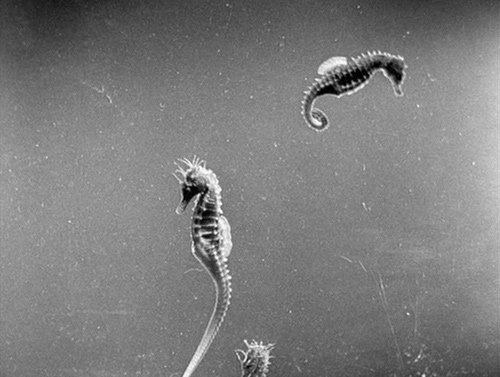At first glance, the appeal of Jean Painlevé’s films is predicated on the alien quality of their subjects. Adopting the form of educational films, these shorts are manifestly endeavors to know more about that which seems strange to us. Watching safely from a theater, we laugh at the notion that an octopus could have a love life and cringe at the feast of a vampire bat. Our fascination is self-evident—these creatures are not like us.
It seems bizarre then that Painlevé should narrate these creatures’ daily adventures in such a personifying manner. This narrative approach is especially evident in Le vampire (1945), in which Painlevé’s narration is at once the vampire’s and the bat’s. “It moves like a cripple,” says the narrator, “limping on its hindlegs and leaning on the bent thumbs of its forelegs.” Never once does Painlevé step back to explain the literal division between the vampire bat and Nosferatu, a character whose monstrousness is paradoxically dependent on its human likeness (not to mention that it is played by a human actor). Instead, he narrates as if the bat and the character are one. At its core, the legend of the vampire itself is predicated on the mysterious connection between human and monster—as with any monstrous legend, there is the underlying potential for a human to transform into a creature. Always, however, this creature maintains a certain similarity to its previous human form. Painlevé merely adds another mirror to the equation—if the vampire bat is like Nosferatu, then who is to say that it is not like us?

As we follow the exploits of Painlevé’s creatures, we further identify with their simultaneously banal and performative natures. Although it seems appropriate that a study of these animals should include their eating, mating, and combative practices, they are nonetheless quite foreign to us (the strange fertility of the octopus, for example). The essential narrative of these creatures’ lives, though, is woven from the same thread as ours. We see them kill and give birth, just as we do, and often, these rituals border on performance. In Le bal des sorcières (1972), we see primordial-seeming mollusks engage in an essentially human institution: dance. “As with other animals,” we hear, “dancing is a way of finding a partner.” That the word “animals,” and not “humans” is used is, in itself, a ligament tying these alien creatures to us. Purely on the basis of the food chain, we are connected to these animals; we are neither the highest nor the lowest, and we consume these animals just as they consume each other. Although these animals are explicitly likened to horses and even King Charles Spaniels, to unlock the latent pretense of these films, one must remember that we, too, are animals. Combat, too, is a kind of performance to which we can relate; “we are not watching a game but a fight to the death,” we hear in Assassins de l’eau douce (1947), and suddenly, it seems more like we are watching a battle between Hector and Achilles than between water insects. These ties are likely purposeful, as Painlevé highlights them using filmic techniques, from the comedic jump cut to the humanistic close-up. Painlevé’s films simultaneously personify the nearly inanimate and normalize the bizarre. They humanize the monstrous.
If these creatures are performers, however, what does it mean that, as their audience, we laugh? Seated amongst intellectuals and students at Painlevé’s screening in Kino Tuškanac last Tuesday, I was not the only one laughing; the Charlie Chaplinesque music played in the background casts these animals in the role of a Vaudeville actors. It is easy, at first, to feel distanced from the “performers” on the screen, especially when we could not peer into their alien bodies in the first place without sophisticated technology—we sit down in the theater as higher creatures, laughing at the juxtaposition of alien images and humanistic film devices. We do not stay that way, however, as we realize just how close we are to the octopus, the vampire bat, and the mollusk. Perhaps in some ways, laughing is a way of passively expressing our discomfort with how alike we are to these creatures, but more concretely, it is an expression of our identification with them. Because their daily life is intertwined with their role as performers, we can begin to see these animals not as creatures, but as actors. They eat, mate, and bleed just as we do, and their struggles are dramatized in the same way as those of any character on the big screen. In this way, our experience with Painlevé’s films approaches an uncomfortable catharsis—though outwardly estranged from humanity, these animals are like us. An educational film about the biology of insects and sea creatures thus becomes a statement about human strangeness.
Gina Hackett